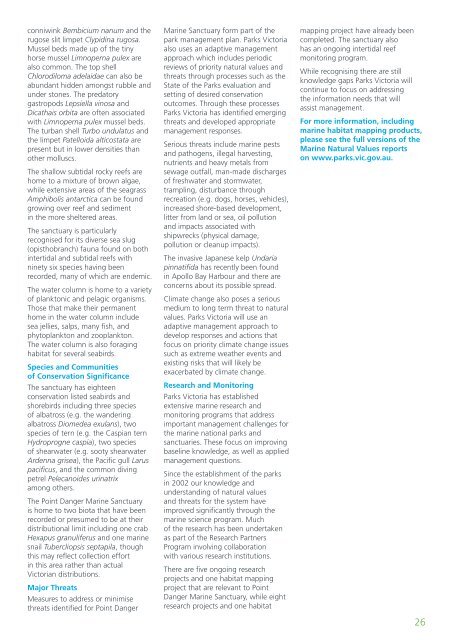Marine Natural Values Study Summary - Parks Victoria
Marine Natural Values Study Summary - Parks Victoria
Marine Natural Values Study Summary - Parks Victoria
Create successful ePaper yourself
Turn your PDF publications into a flip-book with our unique Google optimized e-Paper software.
conniwink Bembicium nanum and therugose slit limpet Clypidina rugosa.Mussel beds made up of the tinyhorse mussel Limnoperna pulex arealso common. The top shellChlorodiloma adelaidae can also beabundant hidden amongst rubble andunder stones. The predatorygastropods Lepsiella vinosa andDicathais orbita are often associatedwith Limnoperna pulex mussel beds.The turban shell Turbo undulatus andthe limpet Patelloida alticostata arepresent but in lower densities thanother molluscs.The shallow subtidal rocky reefs arehome to a mixture of brown algae,while extensive areas of the seagrassAmphibolis antarctica can be foundgrowing over reef and sedimentin the more sheltered areas.The sanctuary is particularlyrecognised for its diverse sea slug(opisthobranch) fauna found on bothintertidal and subtidal reefs withninety six species having beenrecorded, many of which are endemic.The water column is home to a varietyof planktonic and pelagic organisms.Those that make their permanenthome in the water column includesea jellies, salps, many fish, andphytoplankton and zooplankton.The water column is also foraginghabitat for several seabirds.Species and Communitiesof Conservation SignificanceThe sanctuary has eighteenconservation listed seabirds andshorebirds including three speciesof albatross (e.g. the wanderingalbatross Diomedea exulans), twospecies of tern (e.g. the Caspian ternHydroprogne caspia), two speciesof shearwater (e.g. sooty shearwaterArdenna grisea), the Pacific gull Laruspacificus, and the common divingpetrel Pelecanoides urinatrixamong others.The Point Danger <strong>Marine</strong> Sanctuaryis home to two biota that have beenrecorded or presumed to be at theirdistributional limit including one crabHexapus granuliferus and one marinesnail Tubercliopsis septapila, thoughthis may reflect collection effortin this area rather than actual<strong>Victoria</strong>n distributions.Major ThreatsMeasures to address or minimisethreats identified for Point Danger<strong>Marine</strong> Sanctuary form part of thepark management plan. <strong>Parks</strong> <strong>Victoria</strong>also uses an adaptive managementapproach which includes periodicreviews of priority natural values andthreats through processes such as theState of the <strong>Parks</strong> evaluation andsetting of desired conservationoutcomes. Through these processes<strong>Parks</strong> <strong>Victoria</strong> has identified emergingthreats and developed appropriatemanagement responses.Serious threats include marine pestsand pathogens, illegal harvesting,nutrients and heavy metals fromsewage outfall, man-made dischargesof freshwater and stormwater,trampling, disturbance throughrecreation (e.g. dogs, horses, vehicles),increased shore-based development,litter from land or sea, oil pollutionand impacts associated withshipwrecks (physical damage,pollution or cleanup impacts).The invasive Japanese kelp Undariapinnatifida has recently been foundin Apollo Bay Harbour and there areconcerns about its possible spread.Climate change also poses a seriousmedium to long term threat to naturalvalues. <strong>Parks</strong> <strong>Victoria</strong> will use anadaptive management approach todevelop responses and actions thatfocus on priority climate change issuessuch as extreme weather events andexisting risks that will likely beexacerbated by climate change.Research and Monitoring<strong>Parks</strong> <strong>Victoria</strong> has establishedextensive marine research andmonitoring programs that addressimportant management challenges forthe marine national parks andsanctuaries. These focus on improvingbaseline knowledge, as well as appliedmanagement questions.Since the establishment of the parksin 2002 our knowledge andunderstanding of natural valuesand threats for the system haveimproved significantly through themarine science program. Muchof the research has been undertakenas part of the Research PartnersProgram involving collaborationwith various research institutions.There are five ongoing researchprojects and one habitat mappingproject that are relevant to PointDanger <strong>Marine</strong> Sanctuary, while eightresearch projects and one habitatmapping project have already beencompleted. The sanctuary alsohas an ongoing intertidal reefmonitoring program.While recognising there are stillknowledge gaps <strong>Parks</strong> <strong>Victoria</strong> willcontinue to focus on addressingthe information needs that willassist management.For more information, includingmarine habitat mapping products,please see the full versions of the<strong>Marine</strong> <strong>Natural</strong> <strong>Values</strong> reportson www.parks.vic.gov.au.26
















